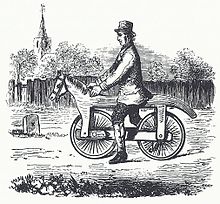Celérifère

Célérifère , German a Celerifer, describes a French express coach and not a non-steerable human powered two-wheeler that was developed by the false Count de Sivrac and presented to the Paris public in June 1791. The driver sitting on top of it pushes himself and the vehicle forward with his feet against the ground. The false celérifère is said to have been developed against the background and in the spirit of the French Revolution . Your mistake as a two-wheeler has been considered a fake since Jacques Seray at the International Cycling History Conference (ICHC). Two-wheelers manufactured in the Nuremberg area as early as the first half of the 18th century were a German counterfeit.
Hearsay guesswork
These two-wheelers, often with animal heads, allegedly known as Vélocifère from 1793 onwards, are said to have taken a permanent place in Parisian society with enthusiastic supporters grouped together in clubs. In 1802 a Paris newspaper reported for the first time about races between aristocratic Vélocifère drivers that took place on the Rue Royale and the Champs-Élysées - with a lot of cracking of the whips, i.e. H. on horse and cart! Using them as props, an operetta entitled Les Vélocifères by Emmanuel Dupaty is said to have premiered on March 19, 1804 in the Théâtre du Vaudeville . "In 1808 this thing became fashionable".
"The time was ripe for a toy like this."
By Joseph Nicephore Niépce is reported that he allegedly until 1816 a steering-less bicycle in the Jardin du Luxembourg 've driven. It was not until 1818 that he had a steerable impeller; With the invention of the steerable trolley, the unguided Célérifèren disappeared.
Legend
The existence of the false Célérifère disseminating secondary literature relates largely to a paper by Louis Baudry de Saunier published in 1891. Jacques Seray (1977) was the first to say that this does not prove the existence of the Célérifère. For Hans-Erhard Lessing , based on Seray's research, the false Célérifère is a “French legend” against the invention of the running machine by the German Karl von Drais . Celerifere or Velocifere were four-wheeled vehicles in a "contemporary express coach service", and it was a certain "Jean-Henry Sievrac" from Marseille who imported "British express coaches 1817". A Canadian linguist pointed out the wrong translation of the word in his dissertation from 1950. According to Lessing, Baudry de Saunier "dated the hoax to 1791 so that his book would appear on the centenary [anniversary of the Célérifère]". According to Lessing, the “de Sivrac legend” was supposed to push “the inventiveness of the walking machine [by Drais] to zero”. Another criticism is that early bicycle historians - like Saunier - deliberately placed the origin of the bicycle in the past in order to place the share of their own nation as high as possible.
- Illustrations of false celerifers in the book by Louis Baudry de Saunier
literature
- Joseph Firth Bottomley: The Velocipede: Its Past, Its Present, and Its Future. London 1869. [3]
- Ludwig Croon: The bicycle and its development. Deutsches Museum , Treatises and Reports. VDI-Verlag, Berlin 1939.
- Anton Daul: Illustrated history of the invention of the bicycle and the development of motorcycles . Creutz publishing house, Dresden 1906.
- Anne-Katrin Ebert: Nations cycling. The history of the bicycle in Germany and the Netherlands up to 1940. Campus Verlag, 2010, ISBN 978-3-593-39158-8 .
- Franz Maria Feldhaus : The technology. A lexicon of prehistoric times, historical times and primitive peoples. Engelmann, Leipzig / Berlin 1914.
- Tony Hadland and Hans-Erhard Lessing: Bicycle Design - An Illustrated History. MIT Press, Cambridge, CA 2015, ISBN 978-0-262-02675-8
- Max JB Rauck, Gerd Volke, Felix R. Paturi: By bike through two centuries. The bicycle and its history. 4th edition. AT Verlag, Aarau et al. 1988, ISBN 3-85502-038-8 .
- Andrew Ritchie: King of the Road. Wildwood House, London 1975, ISBN 0-913668-42-7 .
- Louis Baudry de Saunier: Le cyclisme théorique et pratique. P. Ollendorff, Paris 1891.
- Heinz Schmitt: Karl Friedrich Drais von Sauerbronn: 1785–1851; a Baden inventor; Exhibition for his 200th birthday. Karlsruhe City Archives, Karlsruhe 1985.
- Peter Schneider: The two-wheeler through the ages. German Two-Wheeler Museum Neckarsulm, 1980.
- Jacques Seray: No, Monsieur Baudry de Saunier! The True Origins of the Bicycle. In: The Boneshaker. Volume 10, Number 85, 1977, pp. 9-17.
- Wilhelm Wolf: Bicycle and Cyclist. Leipzig, 1890. (3rd new edition. Dortmund 1988)
- John Woodeford: The Story of the Bicycle. Routledge & Kegan, London 1970, ISBN 0-7100-6816-6 .
Remarks
-
↑ Joseph Firth Bottomley mentions "Celerifere" or the English term "Celeripede" as early as 1869 and already has a drawing of a non-steerable impeller in his book (p. 12.) Cf. [1] .
Wilhelm Wolf (1890, p. 15) mentions “Pariser Stutzer” which he dates “around 1800”.
Individual evidence
- ↑ Andrew Ritchie, p. 17.
- ^ Hadland / Lessing, p. 494
- ^ Feldhaus, addendum p. 11.
- ↑ Louis Baudry de Saunier, p. 22.
- ↑ Peter Schneider: The two-wheeler in the course of time, p. 11.
- ↑ Andrew Ritchie, p. 16.
- ↑ Ludwig Croon, p. 166.
- ↑ Max JB Rauck, p. 16
- ↑ John Woodeford, p. 7
- ↑ Andrew Ritchie, p. 18.
- ↑ Louis Baudry de Saunier, p. 23. [2]
- ^ Les Vélocifères: in google books
- ^ Anton Daul, p. 1.
- ↑ Max JB Rauck, Gerd Volke, Felix R. Paturi, p. 13.
- ↑ Max JB Rauck, Gerd Volke, Felix R. Paturi, p. 13.
- ↑ Max JB Rauck, Gerd Volke, Felix R. Paturi, p. 14.
- ^ Louis Baudry de Saunier, 1891
- ↑ Jacques Seray, 1977
- ↑ Hans-Erhard Lessing in: Heinz Schmitt (Ed.), P. 28.
- ↑ Hans-Erhard Lessing in: Wilhelm Wolf, p. 272.
- ↑ Anne-Katrin Ebert, p. 33.
- ↑ Regarded as Célerpède of Nicéphore Niépce





